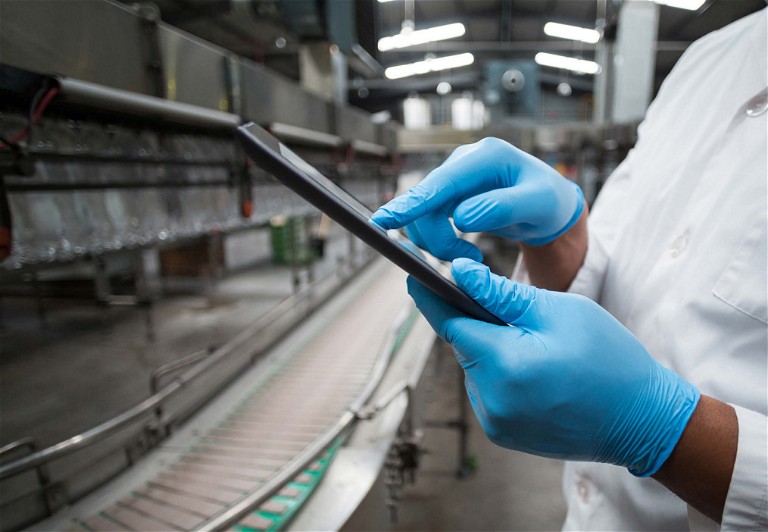Lab Automation: Digitalising Labs
Next-Level Digitalisation: Smart Pharma Production Gets Even Smarter
The digitalisation of pharmaceutical manufacturing has come a long way. However, there are still many ways companies can improve systems to grow even further
Thierry Protas at Antares Vision Group
‘We can do better’; it’s a phrase uttered across all business environments every time a good-but-not-great result emerges from the best of intentions and efforts. In pharma, ‘better’ takes on an elevated urgency to produce more effective medicines with superior quality and in larger quantities.
Fortunately, recent years have seen a pharma manufacturing revolution – and all signs point to ‘better.’ Digitalisation has markedly improved the ways in which pharma manufacturers produce mission-critical medicines, by first capturing and then accurately assessing parameters at various points along production lines.
Necessity is, often, the mother of invention. In the pharma sector, necessity also birthed innovation. For the last decade or so, government regulations have been the genesis of healthcare’s steady march into digitalisation. Deemed crucial to prevent counterfeiting and verify supply chain safety, laws like the EU’s Falsified Medicines Directive (FMD) and the US’ Drug Supply Chain Security Act (DSCSA) first mandated unit-level serialisation of prescription drugs, then, gradually, the establishment of multi-layer parent-child relationships between groupings of products.
Serialisation and aggregation, then, are the Adam and Eve of pharma industry digitalisation. To comply with their reasonable yet revolutionary goals, pharma companies around the world invested in camera, coding and data collection infrastructure, which enabled efficient, reportable, track and trace processes. While the initial capital layouts were substantial, the ends quickly justified the means. Not only was the global drug supply chain made exponentially safer, pharma companies soon learned that the voluminous data required for regulation compliance was a fast track to improved efficiency and quality control mechanisms.
Encouragingly, as the various regional laws took effect and track and trace systems went from modern marvels to must-have mainstays, a ‘competition through uniformity’ element kicked in. Like all sectors, pharma exists in a competitive landscape where a company’s proficiencies must progress over time for it to remain profitable and viable. As worldwide regulations established an increased efficiency baseline, pharma companies became keenly aware that those players fully utilising their data capture technologies to continuously hone production practices would remain at the pinnacle of their respective niches.
‘Here are some brand new tools,’ the track and trace regulations insisted. ‘Use them to comply and survive – but use them wisely to prosper and thrive.’
Take, for example, machine maintenance. The ability to monitor the upkeep of individual production machines in real time allows pharma manufacturers to not only predict a pending breakdown, but prescribe a solution that keeps production pace as close to uninterrupted as possible. At its best, monitoring all equipment along a manufacturing line and analysing that data from a single bird’s eye view platform can approach an ever-elusive total productive maintenance (TPM) scenario, in which breakdowns are anticipated and corrected for in near-real time. Unnecessary downtime is all but eliminated, benefiting both reputations and bottom lines. After all, time is product, meaning, per the age-old adage, time is money. More runtime means greater manufacturing capacity, increased profits and more life-saving pharma products available to consumers worldwide.
Predictive equipment maintenance technology reflects just one of the myriad potential production-improving possibilities emerging from mandatory serialisation and aggregation data gathering. Another is lean manufacturing, which utilises data-driven determinations such as optimised equipment scheduling to maximise productivity and manpower while minimising both machine idling and resource wastage. One term that has come to define a combination of efficiency efforts is operational excellence, which basically refers to optimised parts of a manufacturing business working together in an optimised fashion. For many manufacturers, realising such bonus benefits as add-ons to their initial track and trace investments has become the difference between celebratory successes and unceremonious obsolescence. For example, small- and medium-sized contract manufacturing organisations (CMOs) and contract packaging organisations (CPOs) quickly realised the vital need to improve the availability and performance of their production lines, or else surrender existing and prospective business to bigger contract producers or pharma company insourcing.

But technology – like medical science – advances further with time. We’ve reached a point where pharma lab digitalisation can connect countless key performance indicators (KPIs) along a line, funnel that voluminous, valuable data into an intuitive assessment platform and analyse it from a comprehensive, points-aligned perspective.
A decade into pharma’s digitalisation journey, now is the opportune time to enhance and expedite these approaches through next-generation tools that support superior data collection, more effectively analyse these terabytes of information, and further close the gap between potential and actual operational efficiency and product quality. Pharma manufacturing has smartened up significantly over the past decade. Ever-evolving medicinal needs require it to become even smarter. We’ve come a long way, but the journey to tomorrow’s pharma laboratories is just beginning.
Raising Production’s Ceiling – and Its Floor
Like track and trace before it, a comprehensive, system-wide digital transformation has been elevated from an optional maybe to a certified must. And while, unlike the FMD and DSCSA, the time frame for this next-level digitalisation has no set deadline, its implementation should be nonetheless accelerated. Just as track and trace reset the competitive landscape a few years ago, so will this next-level effort dictate terms starting in the very near future, if it hasn’t already done so.
While it may sound intimidating, there’s a simple, two-word initial question pharma manufacturers can ask themselves at the inception of this journey: ‘What’s left?’
That simple query addresses two issues. First and foremost, it’s an acknowledgment and appreciation that the next level of digitalisation stands upon the shoulders of the initial investments made for track and trace compliance. We’re not starting from square one. The building blocks are all within reach, and the subsequent adaption process will be less disruptive for having gone through this data-centric drive before. From there, ‘What’s left?’ becomes a rallying cry to begin converting from manual to automatic as much as possible, from a data collection and analysis standpoint. The goal here isn’t just eliminating paperwork, but rather to have systems capable of sharing their collected data with other systems that, historically, hadn’t been optimally communicating with one another. Typically, this comprises some combination of automatic data collection from machine Programmable Logic Controllers (PLCs) and Industrial Internet of Things (IIoT) sensors. The goal is to connect everything to the latest generation of software tools for real-time measurement and management of various KPIs.
These complex systems work to simplify production efficiency improvements and quality control, and typically deliver fast-tracked returns on investment that justify their expenses and then some. Promisingly, some companies are already experimenting with AI-enabled systems capable of ‘learning’ their customised production parameters – typically those addressing predictive maintenance, scheduling and inspection processes – to become incrementally more effective.
Though most of these programmes are still in pilot stages, the preliminary results have been encouraging; here, AI elements are essentially acting as digitalisation on steroids, further bolstering the non-AI system’s already near-peak performance. It also helps make increasingly informed recommendations based on mountains of data, perfecting its prescriptive approach as it experiences ever more circumstances.
Eventually, such Deep Learning capabilities will become part and parcel to enhanced digitalisation’s full maturation. Again, we find the difference between ‘smart’ and ‘smarter.’ For example, such advanced algorithmic monitoring can not only detect a looming equipment breakdown, but consider previous problems and their various symptoms. With this comprehensive picture in mind, the system can then offer a recommendation that conventional data collection setups likely would have misinterpreted or overlooked. With such precise troubleshooting made well in advance, AI’s prescriptive approach decreases even planned maintenance periods, tightening production time frames and opening up more line or equipment availability. From there, AI can take these newly optimised processes and suggest a production schedule that further grows total facility capacity.
But of course, it’s not just how quick a pharma manufacturer can produce drugs, but also how well it can produce them. Not surprisingly, AI’s deep reinforcement learning techniques also can be readily applied to improve and maintain overall product quality. Over time, such systems become adept at predicting the quality of a given batch by analysing the ‘health’ of the production line itself.
AI will also improve in-process control. Already, it is proving adept at gaining higher quality defect detection and analysis, particularly in more difficult-to-inspect platforms like vials and syringes filled with liquids, as well as lyophilised products.
The ability to gradually learn and exactingly discern precisely what constitutes an out-of-spec flaw is incredibly valuable when flecks and reflections can obfuscate and confuse even the most advanced vision systems.
Ironically, all this technology-driven production optimisation brings us not to a conclusion but rather the beginning – as in, back to the drug development stages. Enhanced digitalisation is charting a course to dramatically improve not only the ways drugs are manufactured en masse, but the ways in which such production is planned from inception.
Already, the most forward-thinking pharma manufacturers are developing a digital twin approach; one that simulates production, allowing it to hone and perfect processes before a single market-ready dose is made. We’re at the point where KPIs are predating APIs – and the result will benefit both drugmakers and consumers. This tactic is primed to produce best-possible quality in highest-possible amounts and shortest-possible time frames.
Of course, pharma companies have a range of equipment, needs, goals and practices as broad and varied as the drugs they produce. Other factors, including the impact on human resources and the need to train personnel on next-level data collection and prescription systems, also play a role in how fast this shift occurs. This means some companies invariably are further along the enhanced digitalisation path than others.
Regardless, the train has left the station… destination enhanced digitalisation. Even those companies at or near the back will inevitably come along for this transformational ride. In fact, their continued viability depends on it.

Thierry Protas is digital factory business owner for Antares Vision Group. Thierry has 25 years of experience helping pharmaceutical companies implement automatic and robotic manufacturing solutions, including Levels 1-5 track & trace, visual inspection and labelling systems.